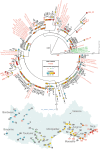Multiplexed amplicon sequencing reveals the heterogeneous spatial distribution of pyrethroid resistance mutations in Aedes albopictus mosquito populations in southern France
- PMID: 39731105
- PMCID: PMC11674153
- DOI: 10.1186/s13071-024-06632-8
Multiplexed amplicon sequencing reveals the heterogeneous spatial distribution of pyrethroid resistance mutations in Aedes albopictus mosquito populations in southern France
Abstract
Background: The risk of mosquito-borne disease transmission is increasing in temperate climates with the colonization and proliferation of the Asian tiger mosquito vector Aedes albopictus and the rapid mass transport of passengers returning from tropical regions where viruses are endemic. The prevention of major Aedes-borne viruses heavily relies on the use of insecticides for vector control, mainly pyrethroids. In Europe, only deltamethrin is authorized.
Methods: High-throughput molecular assays can provide a cost-effective surrogate to phenotypic insecticide resistance assays when mutations have been previously linked to a resistance phenotype. Here, we screened for the spatial distribution of knockdown resistance (kdr) mutations at a large scale using a two-step approach based on multiplexed amplicon sequencing and an unprecedented collection of field-derived mosquitoes from 95 sites in 61 municipalities, alongside a west-to-east transect in the south of France, from June to September 2021.
Results: We identified the presence of the V1016G allele in 14 sites. The V1016G allele was predominantly found in southeast France close to the Italian border, with two additional isolated sites close to Bordeaux and Marmande. All mosquitoes were heterozygous for this mutation and should not be phenotypically resistant to pyrethroid insecticide. Four other mutations were identified in our targeted genomic sequence: I1532T, M1006L, M1586L, M995L. Sequencing a section of maternally inherited mitochondrial genome confirmed that the spread of Ae. albopictus in France originated from founders within haplogroup A1.
Conclusions: These findings contribute to the broader understanding of resistance dynamics in Europe and can inform targeted approaches to mitigate the impact of resistance on vector control.
Keywords: Aedes albopictus; Amplicon sequencing; Arbovirus; Knock-down resistance; Molecular surveillance; Pool DNA-sequencing; Pyrethroid resistance.
© 2024. The Author(s).
Conflict of interest statement
Declarations. Ethics approval and consent to participate: Not applicable. Consent for publication: Not applicable. Competing interests: The authors declare no competing interests.
Figures


References
-
- Hemingway J, Beaty BJ, Rowland M, Scott TW, Sharp BL. The innovative vector control consortium: improved control of mosquito-borne diseases. Trends Parasitol. 2006;22:308–12. - PubMed
-
- Kasai S, Caputo B, Tsunoda T, Cuong TC, Maekawa Y, Lam-Phua SG, et al. First detection of a Vssc allele V1016G conferring a high level of insecticide resistance in Aedes albopictus collected from Europe (Italy) and Asia (Vietnam), 2016: a new emerging threat to controlling arboviral diseases. Euro Surveill Bull Eur Sur Mal Transm Eur Commun Dis Bull. 2019. 10.2807/1560-7917.ES.2019.24.5.1700847. - PMC - PubMed
-
- Smith LB, Kasai S, Scott JG. Pyrethroid resistance in Aedes aegypti and Aedes albopictus: important mosquito vectors of human diseases. Pestic Biochem Physiol. 2016;133:1–12. - PubMed
MeSH terms
Substances
Supplementary concepts
LinkOut - more resources
Full Text Sources

